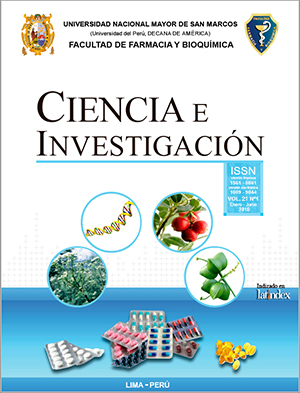Characteristics of poor quality medicines in Peru from 2005-2014
DOI:
https://doi.org/10.15381/ci.v21i1.15739Keywords:
Counterfeit drugs, quality control, PeruAbstract
Objectives: Determine the percentage of medicines of poor-quality: Counterfeit and substandard, analyzed at “Quality Control Center (CNCC)” of National Institutes of Health (NIH), Peru in the period 2005-2014 and determine their types and features. Materials and Methods: A form was created to pick up relevant data directly from CNCC reports and from the Integrated System of Lab Management (SIGEL). Results: The percentage of counterfeit drugs relative to to total drugs evaluated was: 3,0 % in 2005, 5,0 % in 2006, 7,3 % in 2007, and 9,2 % in 2008, 11,4 % in 2009, 6,7 % in 2010, 9,9 % in 2011, 10,6 % in 2012, 8,4 % in 2013 and 7,6 % in 2014. The main groups of counterfeit drugs, classified according to Anatomical Therapeutic Chemical Classification System according to WHO were: Nervous system (21,9 %); antinfectives per sistemic use (20,8 %) and musculo-skeletal system (18,4 %). The most common type of forgery occurred in cases where the drug contained the correct amount of active ingredients, but the manufacturer was not the same that the one stated (44,3 %) and drugs that did not contain active ingredient (37,4 %). The average percentage of substandard quality was 6,8 % between 2005-2014. In the last three years critical tests of this medicines corresponds to 73 %. Conclusions: During the period 2005 and 2009 there was an increased percentage of counterfeit medicines, between 2010 and 2014 this percentage diminished. Respect to substandard medicines, the major percentage corresponds to critical tests that affect severely quality of medicines.Downloads
Published
2019-01-23
Issue
Section
Artículos Originales
License
Copyright (c) 2019 Luis Moreno-Exebio, Freddy Sayritupac, Javier Rodríguez-Calzado, Yesenia Rodríguez-Tanta

This work is licensed under a Creative Commons Attribution-NonCommercial-ShareAlike 4.0 International License.
LOS AUTORES RETIENEN SUS DERECHOS:
- Los autores retienen sus derechos de marca y patente, y tambien sobre cualquier proceso o procedimiento descrito en el artículo.
- Los autores retienen el derecho de compartir, copiar, distribuir, ejecutar y comunicar públicamente el articulo publicado en la Revista Ciencia e Investigación (por ejemplo, colocarlo en un repositorio institucional o publicarlo en un libro), con un reconocimiento de su publicación inicial en la Revista Ciencia e Investigación.
- Los autores retienen el derecho a hacer una posterior publicación de su trabajo, de utilizar el artículo o cualquier parte de aquel (por ejemplo: una compilación de sus trabajos, notas para conferencias, tesis, o para un libro), siempre que indiquen la fuente de publicación (autores del trabajo, revista, volumen, numero y fecha).
How to Cite
1.
Moreno-Exebio L, Sayritupac F, Rodríguez-Calzado J, Rodríguez-Tanta Y. Characteristics of poor quality medicines in Peru from 2005-2014. Ciencia e investigación [Internet]. 2019 Jan. 23 [cited 2024 Jul. 17];21(1):27-34. Available from: https://revistasinvestigacion.unmsm.edu.pe/index.php/farma/article/view/15739













